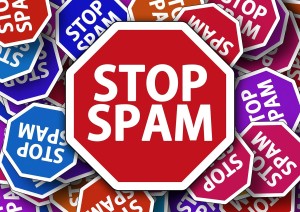3 Things You Need To Do To Avoid Sending Spam

How can you stop spam?
Email marketing has been plagued by one tactic that has always meant that businesses have to be careful how they conduct themselves: spamming. The practice, where customers are sent copious numbers of emails or are sent emails they never wanted, has led to legislation across the world. Some countries have included legislation that has meant that a company found sending spam could face hefty fines.
Spam isn’t exactly worthwhile. Unsolicited emails generally produce poorer results, low return on investment and damage brand reputation. While having a large enough list of names might offer better sales over one email – in the long term and after potential legal costs, the returns will be greatly diminished and your brand’s image ruined.
It is the company which is represented in the email, and not any third party supplier, who is responsible for the conduct of the email marketing campaign. Therefore, it is important that you know how to avoid sending spam. In theory, this only requires the careful implementation of three checks in your campaigns before you send a single email.
Here are the three checks you must complete to avoid sending spam and ensure your subscribers only get the messages they want.
1. Use Volunteers
The first and most important check is to ensure that your subscribers are only those that have signed up to your email marketing list in the first place. It is illegal to send emails to anyone who has not opted to receive emails.
While it is not a legal requirement in every country, the best way to ensure that this step is taken is to use the double opt-in methodology. This is when a subscriber signs up to your mailing list on your website or another platform (i.e. social media) and is then sent an email asking for their confirmation.
This helps to prevent your emails being marked as spam by ensuring that your subscribers know what their actions will result in. It also gives them a chance to say they don’t really want the emails or to prevent a third party from signing up people who have no interest in your products and services.
Many email marketing service providers make this system available as part of their service for free, so there is no complicated programming or other activity to undertake.
2. Segregate Email Subscribers
Another important action is to ensure that you are sending the right emails to your subscribers. This process, known as segmentation, is a vital step to ensure that your business’ contacts aren’t sent marketing messages that they aren’t interested in or that are irrelevant to them.
For instance, imagine you run an electronics store and you have a deal on a complimentary product to another. Sending it to everyone on the list will result in many people receiving the email who don’t have the original product and therefore, buying the complimentary product is not worthwhile. By segmenting the list so that only those who have bought the first product can result in better uptake and results.
Segmentation can take many different directions so it is best to understand your audience and use their behaviours to help you determine what segment they need to be assigned to.
3. Limit Your Email Campaigns
The more emails you send, the more like spammers you will appear. That is the simple conclusion from those that continuously send emails. Customers grow weary, even if all they do is delete your email. Therefore, consider how often you are creating your email campaigns and sending them out.
There isn’t an optimum number for the frequency of emails to send per week as it will differ between audiences, industries and products. However, if you are getting a high proportion of complaints or a high unsubscribe rate with your email campaigns, you might need to rethink your strategy.
If you segment your list, as mentioned above, this can also help reduce the number of emails each subscriber will receive.
Conclusion
Email marketing is highly effective when it comes to generating interest and sales for your brand’s products or services. But it is important that you ensure your company doesn’t practice spamming tactics. To comply with laws and best practice, it is best to use the double opt-in methodology, segment email lists and limit the frequency of emails. This way you will always seem legitimate and be in favour with those on your mailing list.
Read post Post a Comment. Tagged in: email marketing strategy, spam, SPAM laws
Why You Need To Know Your SPAM rules

No-one likes spam, especially the Government! Don’t be caught out by SPAM laws
There is a problem with email marketing, and that is SPAM. The illicit and often annoying issue with email marketing can mean that your customers are turned away from email messages even if the problem is not you.
SPAM comes in many different forms. It can be an email message that was not requested, i.e. the recipient was added to a marketing list without their permission, or an email with a misleading subject line compared to their subject matter, or too many emails being sent.
Many of these SPAM activities are actually against the CAN-SPAM Act of 2003. In other countries, there are similar laws which generally contain the same rules. The laws do make it a little more difficult for you to send commercial emails, but it should give reassurance to customers and offers them a way to complain legitimately about companies who might send irrelevant or dangerous spam.
If you do break the law, there can be stiff fines. The CAN-SPAM Act of 2003 states that if you don’t follow the rules you can be fined up to $16,000 per violation per individual email. In the United Kingdom, the fine is smaller but still significant. Therefore, if you want the financial safety of your business, it’s best to follow the rules.
So what are the ten most important rules of these email marketing laws?
1. Signing Up
A prospect can subscribe to your email marketing list either by giving you verbal or written consent. On a website, this should include ticking a checkbox on a web form. It is also best practice to use the double opt-in sign-up system to ensure those signing up online actually know what they are signing up for.
2. Header Information
Recipients have the right to know who the email is from when it arrives in their inbox. Therefore, you can’t put in misleading or false information in the header. You should include information such as organisation domain name and email address as they appear in your business. It is best practice to have the domain name and sender as an actual person within the organisation.
3. Subject Lines
A good subject line can entice your audience into opening your email and looking at the offer you have inside. But the subject line has to reflect what the email is about. For instance, you can’t say they are getting something for free when you aren’t offering that at all.
4. Identifying Purpose
Customers have become wary of the tactics used by email marketers and therefore have developed a knowledge of when emails are ads. Marketers have since changed tactics to make it less obvious to get customers to re-engage with emails. While this has been effective, it is also against the CAN-SPAM laws. You need to ensure that your customers know that your message is an advert.
5. Location
Recipients need to know where your business is located. This is to demonstrate that you are a real company. To help build trust, ensure that the address of your organisation on the email is the same as the one on Google+.
6. Opting Out
It’s sad to see any subscriber leave your list, but you must give them the option which can either be done via an email message or a link within the email. The latter of these is the best option as it can mean that the process is automatic whereas the former creates more work for you.
7. Processing Opt-Out Requests
Every opt-out request you have from your subscribers needs to be processed quickly, within ten business days. You also need to honour requests from recipients up to 30 days after you’ve sent your email marketing message.
8. Third Party Involvement
If you have a digital marketing company run your email marketing campaigns, you must take responsibility for their actions as well. That is why it is so important that you get references for their work and check they are complying with email marketing laws.
9. Definition
These regulations only apply to commercial content; i.e. when you are promoting a product or service. Any emails that are sent for transactional or relationship reasons (i.e. invoices, warranty information, etc.) don’t have to follow the same rules. However, if you start adding commercial information to the emails, they are liable to follow the laws.
10. Forwarding
Sometimes it can be a great way to spread the word of your brand by asking current subscribers to forward your email to a friend. In these circumstances, you don’t need to worry about the CAN-SPAM laws unless you offer an incentive to send that email like a discount code.
Conclusion
It is crucial that you adhere to the CAN-SPAM Act. Failure to follow these rules can place your business at financial risk as well as annoy your potential customers. So ensure you know the rules and that you are following them.
Do you know your CAN-SPAM Act? Have you broken any of the rules above?
Let us know in the comments below.
Read post Post a Comment. Tagged in: email marketing laws, legal code, legal requirements, SPAM laws